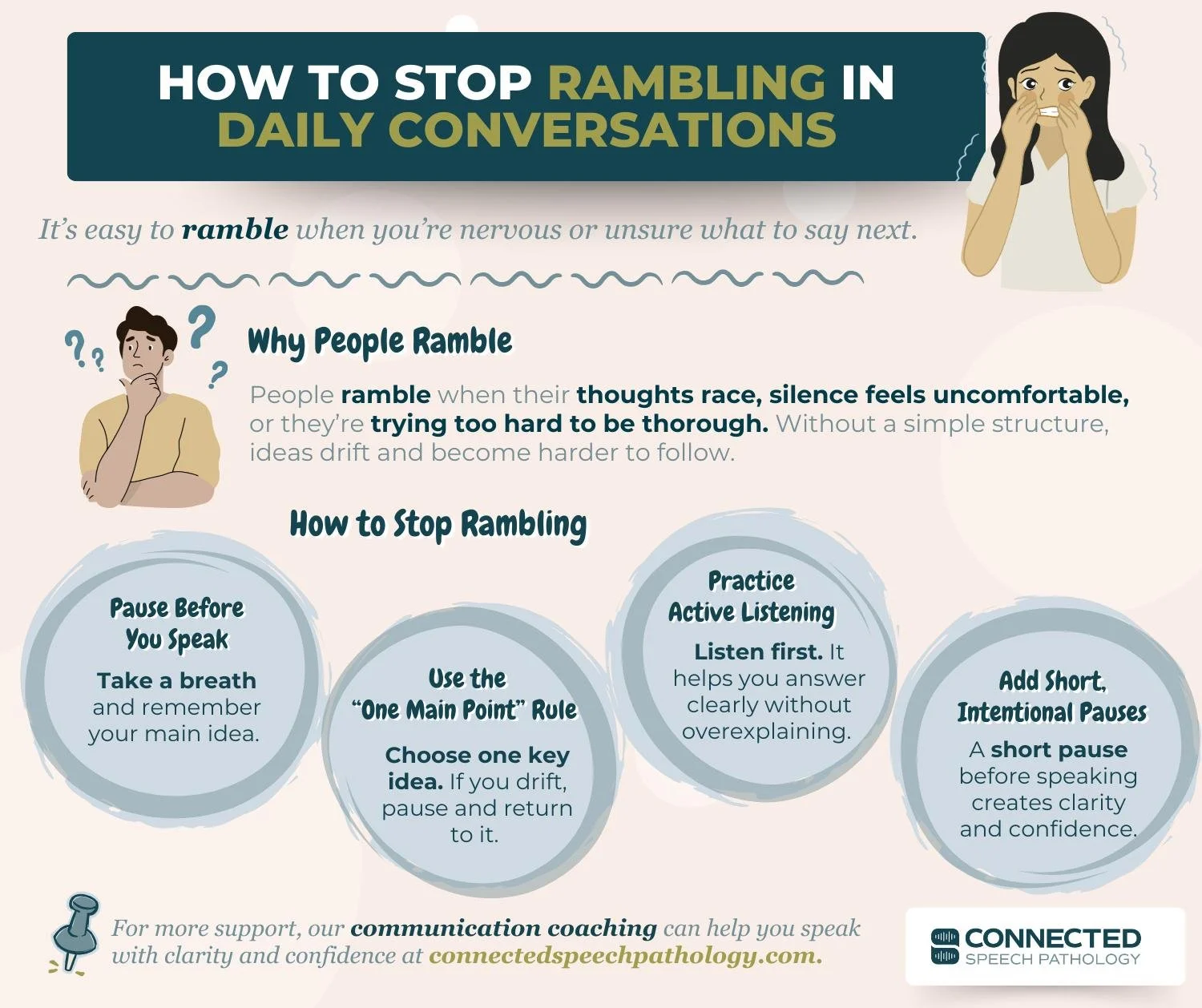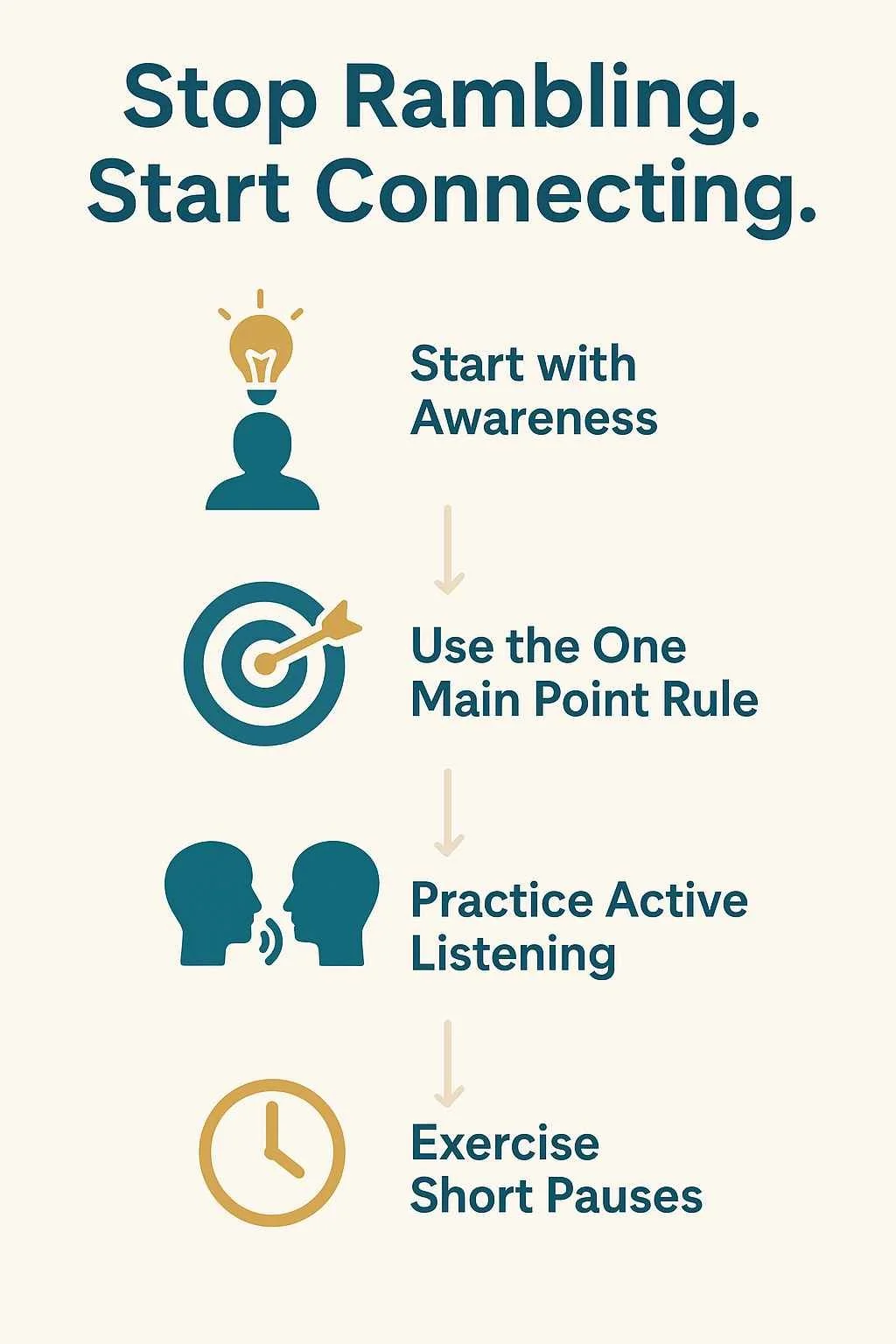How to Stop Rambling and Communicate More Effectively
Have you ever finished talking and realized you lost your train of thought halfway through? Many people find themselves talking in circles when they’re nervous, excited, or unsure how to wrap up an idea. It can leave you feeling like your message didn’t land the way you intended.
Learning to stop rambling helps you sound confident and keep your listener’s attention. You’ll express your ideas more clearly, create stronger connections, and feel in control of your words.
Key Takeaways
Rambling happens when thoughts move faster than words, but you can train yourself to slow down and stay focused.
Preparation and structure help you make clear points, especially in job interviews, meetings, and social situations.
Active listening and pausing before speaking can improve clarity and make others feel heard.
Communication coaches can help you practice concise speaking.
Why People Ramble When They Speak
How to Stop Rambling in Daily Conversations
How to Stop Rambling During Public Speaking
How to Stop Rambling in Job Interviews
Why People Ramble When They Speak
People often ramble because they feel nervous, want to fill a silence, or fear saying the wrong thing. When adrenaline rises, thoughts can race, and sentences stretch without direction.
Another reason people ramble is a lack of structure. Without clear points, conversations can drift from one idea to another. Some people have trouble stopping talking because they hope to sound thorough, but they end up losing focus.
Sometimes the opposite problem occurs, being too quiet or overthinking before speaking. Both habits can block clear communication and reduce confidence in social situations.
How to Stop Rambling in Daily Conversations
Learning to be more precise starts with awareness. You need to catch yourself when you lose track of your main idea or add unnecessary details.
A helpful method is to pause and think before speaking. Take one breath, recall your clear point, then speak one idea at a time. Pauses create space for your listener to process and respond.
It’s funny how we often talk more when we're nervous. Practicing to slow down and wait before your next comment can make your conversation flow naturally and keep the discussion balanced.
Use the “One Main Point” Rule
Before starting a conversation or answering a question, decide on one key point you want to make. For example, in a job interview, focus on one specific example that supports your answer instead of listing multiple stories.
This rule helps your conversation stay clear and easy to follow. The listener will remember your message more easily when it connects to a single strong idea.
If you notice your words wandering, take a short break and refocus on your main point before you continue speaking.
Practice Active Listening
Good communication is as much about listening as it is about speaking. Active listening means paying attention to the other person’s words and expressions before you respond.
When you truly listen, you can answer questions directly and avoid rambling or repeating comments. You’ll also catch the moment when the person is ready to speak, which helps you stop talking at the right time.
Active listening builds connection and trust, making conversations feel more natural and concise.
Exercise Short Pauses
Silence can feel uncomfortable, but short pauses give your speech meaning and structure. Many confident leaders pause between ideas to let their key points sink in.
If you find yourself filling every moment with sound, practice waiting two seconds before you respond. That small bit of silence helps you gather your next thought and create a sense of calm.
Pauses also signal that you’re thinking clearly, not uncertain, which strengthens your confidence in meetings and business discussions.
How to Stop Rambling During Public Speaking
Speaking to a group can make even confident people ramble. When nerves rise, your instinct might be to talk faster or over-explain your points.
Start by writing down your key points before your presentation. This keeps you on track and helps you read the room when adjusting your speaking style. If you drift off topic, gently lead the conversation back to your main idea.
A public speaking coach or executive coach can be very helpful. They can give you tips on body language, pacing, and phrasing that keep your audience engaged and your communication clear.
Use Structure to Stay on Track
A simple structure like “Point, Example, Summary” works for most talks. Start with your main point, give one clear example, then summarize it in one sentence.
For instance, in a meeting, you could say, “The main challenge is client retention. One example is our 20% drop in repeat business last quarter. We can fix this by improving follow-up communication.”
This structure keeps your speech concise and focused. It also shows your listeners that you respect their time and understand the importance of staying on track.
Slow Down to Improve Communication Skills and Clarity
When people feel nervous, they often speak too quickly. This makes it harder for the audience to follow your key message.
Practice speaking slowly and clearly, even when you feel pressure. Slower speech helps you emphasize key words, reduce filler phrases, and stay in control.
If you find yourself rushing, take a deep breath or a short pause between thoughts. Research shows that slowing down improves clarity and confidence in public speaking.
How to Stop Rambling in Job Interviews
Job interviews can be stressful, especially when you want to impress a potential employer. Many people ramble because they fear leaving out details or saying something wrong.
The best way to stop rambling in job interviews is to prepare short, organized answers. Aim to speak for about 60 to 90 seconds per question. If the interviewer wants more detail, they’ll ask a follow-up.
Use the STAR method (Situation, Task, Action, Result) to structure your answers. It helps you explain your experiences clearly, avoid rambling, and make your communication skills stand out.
Practice with a Public Speaking Coach
If you struggle to stay concise, practicing with a professional can make a big difference. A public speaking coach can help you refine your delivery.
During communication coaching sessions, you can practice real-life conversations, record video examples of your speaking habits, and learn how to stop talking once you’ve made your point.
These sessions help you become aware of your speaking tendencies and build a communication style that sounds eloquent, confident, and effective in both meetings and social conversations.
Interview Preparation Coaching
Check out our blog on interview preparation coaching for more information!
Frequently Asked Questions About Rambling
1. What is the best way to be more concise when talking?
The best way to be more precise is to pause and focus on one key point before speaking. Plan your thoughts in short sections, break long ideas into smaller parts, and use pauses to help your listener stay engaged.
2. Why do people ramble when nervous?
People ramble when nervous because their brains race faster than their speech. This can cause long explanations or unnecessary details. Speaking slowly and taking small pauses helps control this habit and keep your communication clear.
3. How can I stop rambling in a job interview?
Prepare focused answers using the STAR (Situation, Task, Action, Result) method to avoid rambling in job interviews. Practice answering questions out loud, time your responses, and ask a friend or coach for feedback.
4. What are some quick tips to avoid rambling in conversations?
Quick tips include taking a breath before speaking, listening carefully, and asking questions to keep the conversation flowing. Imagine you’re explaining something to a client, focus on one main idea, and then stop talking when you’ve made your point.
5. Can communication coaches help people who ramble?
Yes, professional communication coaches can help people who ramble by teaching clear communication strategies. Through coaching, you can learn how to summarize your ideas, stay focused, and use silence effectively during discussions.
How Connected Speech Pathology Can Help
At Connected Speech Pathology, our communication coaching is designed to help you get to the point with clarity and confidence. We focus on practical strategies that make your message more concise and engaging in both professional and everyday conversations.
In coaching sessions, our experienced communication coaches work with you to recognize patterns that may lead to rambling and provide tools to keep your ideas focused. Through real-world practice such as meetings, presentations, and interviews, you’ll learn how to organize your thoughts, highlight key points, and deliver your message with impact.
Our coaching helps you speak with purpose, project confidence, and connect more effectively in every interaction.
Summary
Rambling is a common habit, but it can be changed with awareness and practice. Focusing on one point at a time, slowing your speech, and using pauses helps your message stay clear and focused.
Active listening and organized speaking will help you connect with others and lead effective discussions.
These habits improve not only your communication skills but also your confidence in every part of life, from meetings to conversations with friends.
About the Author
Allison Geller is a communication coach, speech-language pathologist, and founder of Connected Speech Pathology, an international online practice providing professional communication coaching and speech therapy for children, teens, and adults. With more than two decades of experience, she has worked in medical and educational settings, published research on aphasia, and leads a team of specialists helping clients improve skills in public speaking, vocal presence, accent clarity, articulation, language, fluency, and interpersonal communication.









